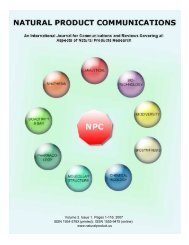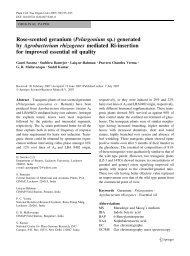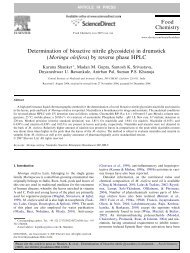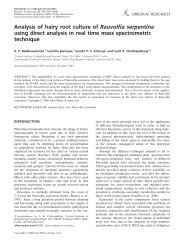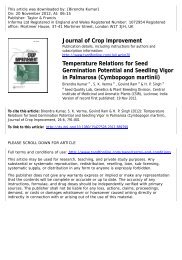Rai A, Smitha SS, Singh AK, Shanker K, Nagegowda ... - CIMAP Staff
Rai A, Smitha SS, Singh AK, Shanker K, Nagegowda ... - CIMAP Staff
Rai A, Smitha SS, Singh AK, Shanker K, Nagegowda ... - CIMAP Staff
- No tags were found...
You also want an ePaper? Increase the reach of your titles
YUMPU automatically turns print PDFs into web optimized ePapers that Google loves.
Page 16 of 20<strong>Rai</strong> et al. • C. roseus Geranyl Diphosphate Synthases2006) was used for transient expression in C. roseus leavesfollowing the protocol of Long et al. (2009). Leaves from thethird developmental stage of C. roseus were vacuum-infiltratedwith A. tumefaciens strain GV3101 containing pEF1.LIS–AmGPPS.<strong>SS</strong>U and pEF1–LIS vector (control) for 15 min andkept for 36 h in the dark in 5% sucrose. The DNA-free totalRNA from infiltrated leaves was isolated as described in the‘Methods’ section. The expression of introduced AmGPPS.<strong>SS</strong>Uwas analyzed by semi-quantitative RT–PCR. Extraction of alkaloidsfrom infiltrated leaves and determination of vindolinecontent by HPLC were carried out using the protocol reportedearlier (<strong>Singh</strong> et al., 2000; Gupta et al., 2005). Briefly, shadedriedleaves (1 g) were powdered and extracted thrice with90% ethanol (3 × 30 ml, 12 h each time). The alcohol extractwas filtered, concentrated to 10 ml, then acidified with 10 mlof 3% HCl and washed thrice with 30 ml hexane. The aqueousportion was basified with ammonia to pH 8.5 and extractedthrice using 30 ml chloroform. The chloroform extract waswashed with water, dried over sodium sulfate, and concentratedunder vacuum. The residue was re-dissolved inmethanol. Methanolic extract and pre-filtered solvents weresubjected to HPLC analysis using a Shimadzu LC-8A gradientHPLC equipped with LC-8A pumps, manual injector valve,SPD-M10Avp PDA detector, and RP-18e reversed-phase chromolithperformance HPLC column.Bioinformatic AnalysisThe predictions of protein subcellular localization were performedusing PSORT (http://psort.ims.u-tokyo.ac.jp/), Predotar(http://urgi.versailles.inra.fr/predotar/predotar.html), ChloroP1.1 (www.cbs.dtu.dk/services/ChloroP/), MitoProt (http://ihg.gsf.de/ihg/mitoprot.html), and TargetP 1.1 (www.cbs.dtu.dk/services/TargetP/).Subcellular Localization StudiesThe subcellular localization of CrGPPSs was studied by generatinggreen fluorescent fusion proteins in-frame withXbaI/BamHI cloning sites of the p326–SGFP vector containingthe CaMV 35S promoter. Full-length ORF of CrGPPSs and theirtruncated variants were amplified with Platinum Taq DNApolymerase High Fidelity (Invitrogen) using respective primersdescribed in Supplemental Table 2. Amplified fragmentswere cloned in-frame with the 5′ end of the GFP codingsequence to generate the CrGPPSs–GFP fusion protein andthen sequenced to confirm accuracy of fusions. Arabidopsisprotoplasts were prepared and transformed as describedpreviously (Sheen, 2002; <strong>Nagegowda</strong> et al., 2008). DNA fromeach construct (10 µg) was used for PEG-mediated transformationof 100 µl of ice-cold protoplasts. p326–sGFP and p326–RbTP–SGFP were used as controls for cytosolic and plastidiallocalization. Transient expression of GFP fusion proteins wasobserved 16–20 h after transformation using a LSM 510 Metaconfocal microscope with a 405 laser-Carl ZEI<strong>SS</strong> in the CentralImaging and Flow Cytometry Facility at the National Centrefor Biological Sciences (NCBS), Bangalore, India.Accession NumbersThe GenBank accession numbers for the sequences mentionedin this article are as follows: AgGPPS1, AF51311; AgGPPS2,AF513112; AgGPPS3, AF513113; AmGPPS.<strong>SS</strong>U, AAS82859;AmGPPS.LSU, AAS82860; AtGGPPS6, At3g14530; AtGPPS,Y17376; At<strong>SS</strong>U-II, At4g38460; CbGPPS.<strong>SS</strong>U, AY534745;CrGGPPS2, JX417186; CrGGPPS3, JX417187; CrGGPPS4,KC288140; CrGPPS, JX417185; CrGPPS.LSU, JX417183; CrGPPS.<strong>SS</strong>U, JX417184; Hl<strong>SS</strong>U, ACQ90681; HlLSU, ACQ90682; LeGPS,DQ286930; MpGPPS.LSU, AF182828; MpGPPS.<strong>SS</strong>U, AF182827;NtGGPPS1, ADD49734; NtGGPPS2, ADD9735; PaIDS1,ACZ57571; PaIDS2, ACA21458; PaIDS3, ACA21459; PbGPPS,EU023907; and QrIDS1, CAC20852.SUPPLEMENTARY DATASupplementary Data are available at Molecular Plant Online.FUNDINGDAN thanks the Department of Biotechnology, Government ofIndia, for the Ramalingaswami Fellowship (BT/HRD/35/24/2006).A.R. and A.K.S. are the recipients of a Research Fellowshipfrom the University Grants Commission, and the Council ofScientific and Industrial Research, respectively.AcknowledgmentsThe authors are grateful to Dr C.S. Nautiyal, Director CSIR–<strong>CIMAP</strong>. D.A.N. expresses his sincere gratitude to ProfessorRam Rajasekharan for his support and encouragement. Ourspecial thanks go to Dr Ajit Shasany for sharing reagents. Theauthors are also thankful to Drs Natalia Dudareva, InhwanHwang, and Makoto Kawamukai for AmGPPS.<strong>SS</strong>U overexpressionconstructs, 326–sGFP, and pACCAR25ΔcrtE vectors,respectively. Confocal images were acquired at the CentralImaging and Flow Cytometry Facility, NCBS, Bangalore. Wethank anonymous reviewers for their comments and suggestions.No conflict of interest declared.ReferencesAerts, R.J., Gisi, D., De Carolis, E., De Luca, V., and Baumann, T.W.(1994). Methyl jasmonate vapor increases the developmentallycontrolled synthesis of alkaloids in Catharanthus and Cinchonaseedlings. Plant J. 5, 635–643.Ament, K., Van Schie, C.C., Bouwmeester, H.J., Haring, M.A., andSchuurink, R.C. (2006). Induction of a leaf specific geranylgeranylpyrophosphate synthase and emission of (E,E)-4,8,12-trimethyltrideca-1,3,7,11-tetraene in tomato are dependenton both jasmonic acid and salicylic acid signaling pathways.Planta. 224, 1197–1208.Arvy, M.P., Imbault, N., Naudascher, F., Thiersault, M., and Doireau,P. (1994). 2,4-D and alkaloid accumulation in periwinkle cell suspensions.Biochimie. 76, 410–416.Downloaded from http://mplant.oxfordjournals.org/ at Central Inst. Of Medicinal & Aromatic Plants (Cimap) on July 17, 2013




